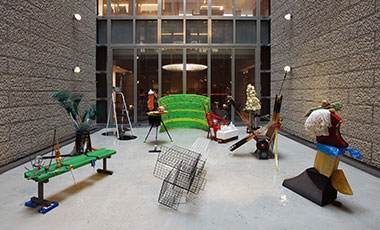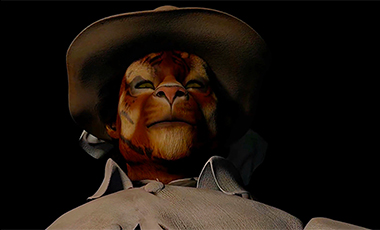In celebration of the publication of TheArtro, it has conceived a special column called 'Art Talk' in which a domestic exhibition that has recently attracted much attention in the Korean art scene is examined from a variety of angles. Its first subject is (Do Ho Suh - Home within Home) , a solo exhibition of Suh’s artworks, which made a spectacular stir in the Korean art scene in the first half of 2012. This exhibition was Suh’s individual show that was presented after the lapse of almost a decade in Korea since his show in 2N3 at Arlsonje Center. The exhibition featured about forty works by Suh in various forms including sculpture, video art and drawing while focusing on one of Suh’s main creative motifs, ‘Home,’ through which Suh has been highly esteemed in the intemational art scene and which has been embodied in his works of the Seongbuk-dong hanok, his past residences in New York and Berlin. Here in this ArtTalk, the exhibition is observed by an architect, an art critic and a design cultural critic from their own articulate points of view.
Sun Do Ho: Transparent and Open Spaces This potable Korean house is my parachute
"This portable Korean house is my parachute." As the words, ‘portable,’ ‘house,’ and ‘parachute’ tell, this sentence of multilayered meaning epitomizes the art of Do Ho Suh. The subject of this sentence is ‘house’, and more specifically, ‘Korean’ house. To Suh, ‘Korea’ is his motherland and is perceived as having a militaristic and rigid hierarchy. In his show in Artsonje Center in 2003 Suh embodied this hierarchical system in his works characterized by their public and universal narratives originated from his personal experiences during his service in the army. The works shown there betokened the myth of collective identity to concatenate the entities of diversity and to bespeak the aspect of coercion caused by it: [Some/One](2002) consisting of an armor made of military dog tags on which soldiers’ name, birth dates and blood types; [High School Uni-form](1996) in which high school uniforms are lined up; [Floor](1997-2000) in which a great number of figures are assembled to form a floor. It is clothes that Suh directed his attention to in expressing those themes. Clothes secure the double task of being of privacy and of the confrontation of what is public. Nothing is either purely private or virtuously public in itself. In other words, it was manifested that his identity is the major subject matter of his artistic work. Clothes are portable. An individual owns clothes and at the same time resides in them. And through this, one faces public spaces. The process of the signification of clothes coincides with ‘portable Korean house’. This is the intersection of the disparate objects of clothes and houses. All the more, Suh’s houses are made of cloth. For Suh, houses and clothes are equal.
Suh leaves ‘home’. This implies his breakaway from his father who emblematizes all that has defined his identity. He left home in Korea and moved to the U.S. This is a physical and simultaneously psychological move. One is freed from being defined by someone else and now his or her inevasible task is defining him or herself all by him or herself. This task is an inexorable and inevitable demand for who has left ‘home’ to meet. Who has left his or her home is inescapably predestined to find or build ‘his or her own’ home, having no longer been able to live in the house of his or her ‘father’. Suh constructs his own home. And he finds ‘his own home’ in a parachute. A parachute is premised on the idea of the invasion of unfamiliar territories. This is not a safely granted entrance through a doorway. Here is activated ever-lasting visible or invisible warnings and refusals against the intruder. This is why not an entrance and exit but a parachute is used. And it should be a ‘safe’ landing. A parachute is an agency through which rejections and cautions can be pacified. Cultural heterogeneity can exist only in the form of ‘the other’. From this angle of perceiving reality, what guarantees the safest settlement is a parachute. For Suh, ‘Korean house’ and ‘parachute’ are of tautology.
The intimate relation between clothes and houses are mentioned above. And it can certainly be applied to parachutes. All of them are the devices that has prescribed, sheltered and nurtured him. The angst that attacks one who have left the arms of his or her ‘father,’ and the anxiousness caused by the need to find another safety. Thus, the device ought to offer the possibility of ‘portableness’. The designation of such meaning based on intimacy has its clear limitation. The extension of signification requires the comprehension of the original meaning of heterogeneity, which forces to refuse, sever and falter that intimacy. Home within Home holds its footing in the element of heterogeneity. The Black Box of Leeum, which is the exhibition space, is a ‘building within building’. Personal and private households are projected to the public institution and space of a museum. The factor of translucency actively captivates a viewer. If the subject of ‘clothes’ has its basis on the perception of the gaze through which one sees him or herself, that of ‘house’can be characterized as a means through which an inquiry into the ways of one’s interrelation with others on the basis of such a perception. The latter is compelled to be accompanied by the former’s process of one’s merciless self-recognition, which can be achieved by the introspective doubting of him or herself. My self-recognition enables my recognition of others. At this point, the relation between 'me' and 'the other' (whether it is another person, a space or a different cultural context) is reestablished. The houses, which normally should possess materialistically imposing solidity, are made of semitransparent fabrics so that a viewer’s eyes constantly float across their insides and outsides. (Furthermore, the exhibition itself regulates such a formula of relation: the museum, the Black Box, Suh’s houses and the unrestrained entrance permitted to the artist.) The relationship between the inside that accommodates the outside and the outside that does the inside destroys the rock-hard system that is a lot like a frozen barrier so as to house an exhaustless supply of inhalation and exhalation. During this process, the artist’s personal memories and sensitivities are liberated to be breathed by people here and there. The choice of a parachute forced by cautions and refusals is maybe an ineluctable behavioral consciousness instigated by the attitude to receive the mutual recognition and tension between the inside and the outside. Suh’s ‘homes’ made of ‘cloth’ are inundated with innumerable artistic languages and approaches traversing those transparent and open spaces.
Do Ho Suh - Home within Home
Written as "Home" and Read as "집" _ Kang Jungeun(Architect)
Suh Do Ho: Transparent and Open Spaces "This potable Korean house is my parachute" _ Lee Daebum(Art critic)
Home within Home_Globalization, Identity and the Mind _ Helen Cho(Design cultural critic)

Lee Daebum / Art critic
Born in 1974 in Seoul, Lee Daebum is currently working as an art critic and independent curator while exchanging with diverse people through ‘roundabout’. ‘roundabout’ is a social project whose outcomes have been the publications of Annotations Without Texts((2010) and 30 Minutes(2012) and the exhibition entitled 강동주: 정전(2012 at 256 Nooha-dong, Jongro-gu, Seoul). Currently, he is conceiving a new project regarding the films in which actor Seong-ki Ahn has taken part. He co-wrote Beyond the Political: The Three Decade of The Hyunsil and Baleon (Hyunsilbook).


